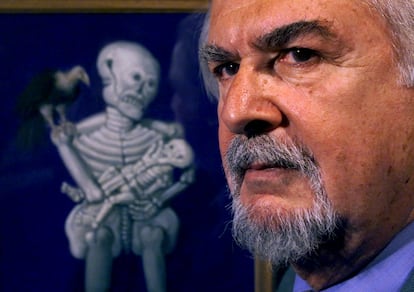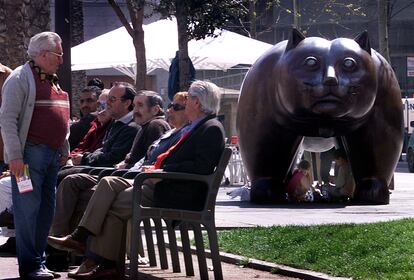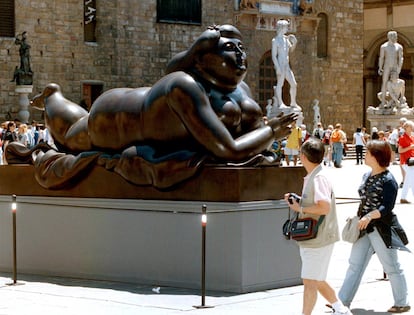Fernando Botero, Colombia’s most universal artist, dies at 91
The nation mourns the passing of the painter and sculptor who became world-famous with his large, rotund figures


Fernando Botero, Colombia’s most universal artist and famous throughout the world for his rotund and voluminous figures, has died at the age of 91. The famous painter and sculptor died at his home in the European principality of Monaco, where he was recovering after recently suffering from pneumonia, as confirmed this Friday by the journalist Julio Sánchez Cristo on W Radio.
Botero, born in Medellín in 1932, was self-taught in every sense of the word. “Art should produce pleasure, a certain tendency towards a positive feeling,” Botero himself stated in 2019 in an interview with EL PAÍS. “But I have painted dramatic things. I have always looked for coherence, aesthetics, but I have painted violence, torture, the passion of Christ... There is a different pleasure in dramatic painting. The greatest joy of painting, beauty, does not put the dramatic and the pleasant at odds,” he stated then.
“It is the inspiring story of a person who started from nothing and the only thing that was clear to him was his artistic vocation, his ability to work, his passion for what he was doing. All of this allowed him to get ahead and swim many times against the predominant currents in the art world,” his daughter Lina Botero said about him in 2019 on the occasion of the documentary Botero: an intimate look at the life and work of the master, a retrospective with unprecedented access to the artist, his family and his private life.

Botero dedicated more than 70 years to his work, which included sculptures, oil paintings, pastels, watercolors and drawings. From very humble origins, his career began as an illustrator for the newspaper El Colombiano in the late 1940s. Very early he recognized himself as the heir of Piero della Francesca, and the genesis of his unmistakable style came at the age of 25, with the sketch of a mandolin that hinted at his sense of monumentality. Long considered one of the greatest living artists, the fame and popularity he had acquired with his luminous colored paintings increased in the 1990s when his enormous bronze sculptures began to be exhibited in the main capitals of the world.
One of the most revealing passages in the documentary is dedicated to Botero’s time in New York, a laboratory of the contemporary avant-garde, where he arrived with $200 in his pocket in the 1960s. He says that at some point during those difficult years he only had $27 left in his savings account. Before the cameras, two of his children, Lina and Juan Carlos – a renowned writer – open a warehouse in the Big Apple that remained sealed for decades. There they discover letters, sketches and paintings that reveal the searches and struggles of that thirty-something artist who swam against the currents of his time.
In the 1970s he moved to Paris, where the greatest tragedy of his life took place. In an accident with a truck he saw Pedro, the child of his second marriage, die at the age of four. Botero himself lost part of his right hand, and for several months he could not paint and had to undergo physical therapy. He locked himself in his studio to recreate Pedrito’s face over and over again.

Despite having lived in Mexico, New York, Monaco and Paris, Botero never lost sight of his home country. His childhood memories, of the world of Medellín in the 1930s and 1940s, inspired much of his work. He had the deep conviction that the more local art seems, the more universal it is.
At the turn of the century, he donated his entire art collection to Colombia in what he came to consider the most important and satisfying decision of his life.
Sign up for our weekly newsletter to get more English-language news coverage from EL PAÍS USA Edition
Tu suscripción se está usando en otro dispositivo
¿Quieres añadir otro usuario a tu suscripción?
Si continúas leyendo en este dispositivo, no se podrá leer en el otro.
FlechaTu suscripción se está usando en otro dispositivo y solo puedes acceder a EL PAÍS desde un dispositivo a la vez.
Si quieres compartir tu cuenta, cambia tu suscripción a la modalidad Premium, así podrás añadir otro usuario. Cada uno accederá con su propia cuenta de email, lo que os permitirá personalizar vuestra experiencia en EL PAÍS.
¿Tienes una suscripción de empresa? Accede aquí para contratar más cuentas.
En el caso de no saber quién está usando tu cuenta, te recomendamos cambiar tu contraseña aquí.
Si decides continuar compartiendo tu cuenta, este mensaje se mostrará en tu dispositivo y en el de la otra persona que está usando tu cuenta de forma indefinida, afectando a tu experiencia de lectura. Puedes consultar aquí los términos y condiciones de la suscripción digital.
More information
Últimas noticias
Petro claims the ELN was the target of US attack in Venezuela
Maduro counterattacks Trump with rhetoric and announces downing of nine drug trafficking aircraft
‘Ecce Homo’: The miraculous disaster that made a small Spanish town famous
Return to sex testing at the Olympics: IOC edges closer to banning transgender women
Most viewed
- Sinaloa Cartel war is taking its toll on Los Chapitos
- Oona Chaplin: ‘I told James Cameron that I was living in a treehouse and starting a permaculture project with a friend’
- Reinhard Genzel, Nobel laureate in physics: ‘One-minute videos will never give you the truth’
- Why the price of coffee has skyrocketed: from Brazilian plantations to specialty coffee houses
- Silver prices are going crazy: This is what’s fueling the rally









































